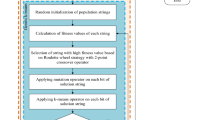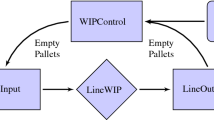Abstract
Flow time of semiconductor manufacturing factory is highly related to the shop floor status; however, the processes are highly complicated and involve more than 100 production steps. Therefore, a simulation model with the production process of a real wafer fab located in Hsin-Chu Science-based Park of Taiwan is built for further studying of the relationship between the flow time and the various input variables. In this research, a hybrid approach by combining Self-Organizing Map (SOM) and Case-Based Reasoning (CBR) for flow time prediction in semiconductor manufacturing factory is developed. And Genetic Algorithm (GA) is applied to fine-tune the weights of features in the CBR model. The flow time and related shop floor status are collected and fed into the SOM for clustering. Then, a corresponding SGA-CBR method is selected and applied for flow time prediction. Finally, using the simulated data, the effectiveness of the proposed method (SGA-CBR) is shown by comparing with other approaches.
Similar content being viewed by others
References
Anklesaria K.P., Drezner Z. (1986) A multivariate approach to estimating the completion time for PERT networks. Journal of the Operational Research Society 37(8): 811–815
Backus P., Janakiram M., Mowzoon S., Runger G.C., Bhargava A. (2006) Factory cycle-time prediction with a data-mining approach. IEEE Transactions on Semiconductor Manufacturing 19(2): 252–258
Bookbinder J.H., Noor A.I. (1985) Setting job-shop due-dates with service-constrains. Journal of the Operational Research Society 36(11): 1017–1026
Cao L. (2003) Support vector machines experts for time series forecasting. Neurocomputing 51: 321–339
Carpinteiro O.A.S., Lima I., Leme R.C, de Souza A.C.Z., Moreira E.M., Pinheiro C.A.M. (2007) A hierarchical neural model with time windows in long-term electrical load forecasting. Neural Computing & Applications 16(4): 465–470
Chang P.C., Hsieh J.C. (2003) A neural networks approach for due date assignment in a wafer fabrication factory. International Journal of Industrial Engineering 10: 55–61
Chang P.C., Hsieh J.C., Liao T.W. (2001) A case-based reasoning approach for due-date assignment in a wafer fabrication factory. Lecture Notes in Computer Science 2080: 648–659
Chang P.C., Hsieh J.C., Liao T.W. (2005) Evolving fuzzy rules for due-date assignment problem in semiconductor manufacturing factory. Journal of Intelligent Manufacturing 16(5): 549–557
Chang P.C., Lai C.Y. (2005) A hybrid system combining self-organizing maps with case-based reasoning in wholesaler’s new-release book forecasting. Expert Systems with Applications 29(1): 183–192
Chang P.C., Liao T.W. (2006) Combing SOM and fuzzy rule base for flow time prediction in semiconductor manufacturing factory. Applied Soft Computing 6(2): 198–206
Chang P.C., Wang Y.W., Ting C.J. (2008) A fuzzy neural network for the flow time estimation in a semiconductor manufacturing factory. International Journal of Production Research 46(4): 1017–1029
Chen T. (2006) A hybrid SOM-BPN approach to lot output time prediction in a wafer fab. Neural Processing Letters 24(3): 271–288
Chen T. (2007a) An intelligent hybrid system for wafer lot output time prediction. Advanced Engineering Informatics 21: 55–65
Chen T. (2007b) Predicting wafer lot output time with a hybrid FCM-FBPN approach. IEEE Transactions on Systems, Man, and Cybernetics—Part B: Cybernetics 37(4): 784–793
Chen T. (2007c) A fuzzy-neural approach with BPN post-classification for job completion time prediction in a semiconductor fabrication plant. Advances in Soft Computing 41: 580–589
Chen D., Burrell P. (2001) Case-based reasoning system and artificial neural networks: A review. Neural Computing & Applications 10: 264–276
Cheng T.C., Gupta E. (1985) Survey of scheduling research involving due-date determination decisions. European Journal of Operational Research 36(11): 1017–1026
Chiang C.C, Ho M.C., Chen J.A. (2006) A hybrid approach of neural networks and grey modeling for adaptive electricity load forecasting. Neural Computing & Applications 15(3–4): 328–338
Chiu C.C., Chang P.C., Chiu N.H. (2003) A case-based expert support system for due date assignment in a wafer fabrication factory. Journal of Intelligent Manufacturing 14: 287–296
Conway R.W., Maxwell W.L., Miller L. W. (1967) Theory of scheduling. Addison-Wesley, Massachusetts
Elmaghraby S.E., Ferreira A.A., Tavares L.V. (2000) Optimal start times under stochastic activity durations. International Journal of Production Economics 64: 153–164
Foster W.R., Gollopy F., Ungar L.H. (1992) Neural network forecasting of short, noisy time series. Computers in Chemical Engineering 16(4): 293–297
Kalaitzakis K., Stavrakakis G.S., Anagnostakis E.M. (2002) Short-term load forecasting based on artificial neural networks parallel implementation. Electric Power Systems Research 63(3): 185–196
Kodogiannis V., Lolis A. (2002) Forecasting financial time series using neural network and fuzzy system-based techniques. Neural Computing & Applications 11(2): 90–102
Koutroumanidis T., Iliadis L., Sylaios G.K. (2006) Time-series modeling of fishery landings using ARIMA models and fuzzy expected intervals software. Environmental Modelling and Software 21(12): 1711–1721
Lin C.J., Xu Y.J. (2006) A self-adaptive neural fuzzy network with group-based symbiotic evolution and its prediction applications. Fuzzy Sets and Systems 157(8): 1036–1056
Milidiú R.L., Machado R.J., Rentería R.P. (1999) Time-series forecasting through wavelets transformation and a mixture of expert models. Neurocomputing 28(1–3): 145–156
Philipoom P.R., Wiegmann L., Rees L.P. (1997) Cost-based due date assignment with the use of classical and neural network approaches. Naval Research Logistics 44: 21–46
Piramuthu S. (1991) Theory and methodology financial credit-risk evaluation with neural and euralfuzzy systems. European Journal of Operational Research 112: 310–332
Pontrandolfo P. (2000) Project duration in stochastic networks by the PERT-Path technique. International Journal of Project Management 18: 215–222
Ragatz G.L., Mabert V.A. (1984) A simulation analysis of due date assignment. Journal of Operations Management 5: 27–39
Sculli D. (1983) The completion time of PERT networks. Journal of the Operational Research Society 34(2): 155–158
Sfetsos A., Siriopoulos C. (2004) Combinatorial time series forecasting based on clustering algorithms and neural networks. Neural Computing & Applications 13: 56–64
Song D.P., Hicks C., Earl C.F. (2002) Product due date assignment for complex assemblies. International Journal of Production Economics 76: 243–256
Watson, I., & Gardingen, D. (1999). A distributed cased-based reasoning application for engineering sales support. In Proceedings of the 16th International Joint Conference on Artificial Intelligence (Vol. 1, pp. 600–605).
Weeks J.K. (1979) A simulation study of predictable due-dates. Management Science 25: 363–373
Yano C.A. (1987) Stochastic lead-times in two-level assembly systems. IIE Transactions 19(4): 371–378
Author information
Authors and Affiliations
Corresponding author
Rights and permissions
About this article
Cite this article
Chang, PC., Fan, C.Y. & Wang, YW. Evolving CBR and data segmentation by SOM for flow time prediction in semiconductor manufacturing factory. J Intell Manuf 20, 421–429 (2009). https://doi.org/10.1007/s10845-008-0116-2
Received:
Accepted:
Published:
Issue Date:
DOI: https://doi.org/10.1007/s10845-008-0116-2




